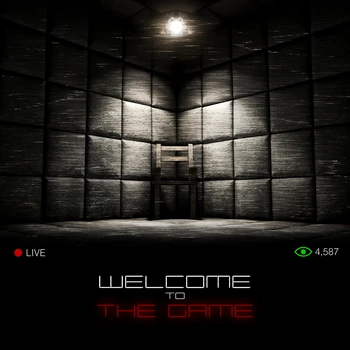
Welcome to the Game is a puzzle horror game by Reflect Studios, famous for previously developing Rides with Strangers.
It was released on June 15, 2016 on Steam, received DLC over a year later, and a sequel almost two years later.
Story and Gameplay
The player is bound to the chair in front of their desktop computer where, after receiving an optional tutorial from their online friend, they can access the Deep Web via the A.N.N (Anonymous Node Network) browser. They're then given a list of websites to navigate around in search of a Red Room, a service that streams actual live torture. Some websites hide a small piece of code called "keys" that, once put together (preferably through notes), will form the URL of a Red Room. There are 8 hidden keys. Red Rooms are only online for 30 days, giving the player a limited period of time to complete their goal. After time is up: Game Over.
All the while, they are constantly getting hacked, which can be quelled by completing certain minigames in a limited period of time, such as copying lines of code or navigating around a network of arranged arrows. They can also temporarily disable all hacking attempts by resetting their IP with the modem, although this long procedure leaves the player incredibly vulnerable. The deeper the player gets into the web, the higher risk they have of a Kidnapper tracking them and breaking into their house. The Kidnapper can only be warded off if the player turns off the lights with the light-switch behind them and stays dead still and quiet for a while. The Kidnapper's presence can be revealed by background knocking, creaking, or location services being activated on your computer, which is shown by a white GPS arrow next to your WiFi indicator. The Breather also frequently tries breaking into the player's house after taunting them over the phone and busting through their front door, forcing the player to hold the knob shut and brace themselves as he tries to kick the door down.
Upon solving all the puzzles, gathering all 8 keys, and making a URL out of them, the player can finally access a Red Room where a cutscene plays, showing a live snuff film between the Executioner and the Victim before the credits roll. This is merely the default ending. See the Endings page for the other two.
For further information, go here.
Development
Welcome to the Game was meant to be a small side project of Reflect Studios to their much bigger upcoming title, Rides with Strangers. Development, mostly behind Reflect Studios' Adam Flatau, happened throughout early 2016, and a small roster of popular YouTubers were sent demos of the game to record their first impressions and spread the word of the game's development throughout late May 2016.
The let's plays of the demo quickly garnered the game enough positive attention to be greenlit on Steam, and although the game was originally meant to be released June 6, 2016 (6-6-16, a reference to the Number of the Beast), Adam decided to spend the next 9 days polishing it, finally releasing it on Steam on the 15th of June for 2 dollars (1.79 for the first week and certain Steam sales).
After months of teasing, a massive update known as Welcome to the Game 2.0 was released November 10, 2016, doubling the game's content with two extra endings, the Breather, the phone, a bigger house, a different kind of hack, the modem, 30+ more websites to explore, and Hacker Mode. On August 31, 2017, the game's price was reluctantly bumped up to five dollars to help fund the development of Rides With Strangers and Casual Mode was added in the 2.2 update.
Reception
As proven by hundreds of Steam reviews, Welcome to the Game is very well-received and acclaimed as a unique and interesting puzzle/horror game. However, common criticisms for the game include annoyingly frequent Hacking incidents, the extremely difficult Kidnapper mechanic, glitches, browsing the Deep Web being overall boring thanks to lack of content and slow page load times, and a lackluster ending. However, these issues have been more or less fixed thanks to patches and the 2.0 update.
